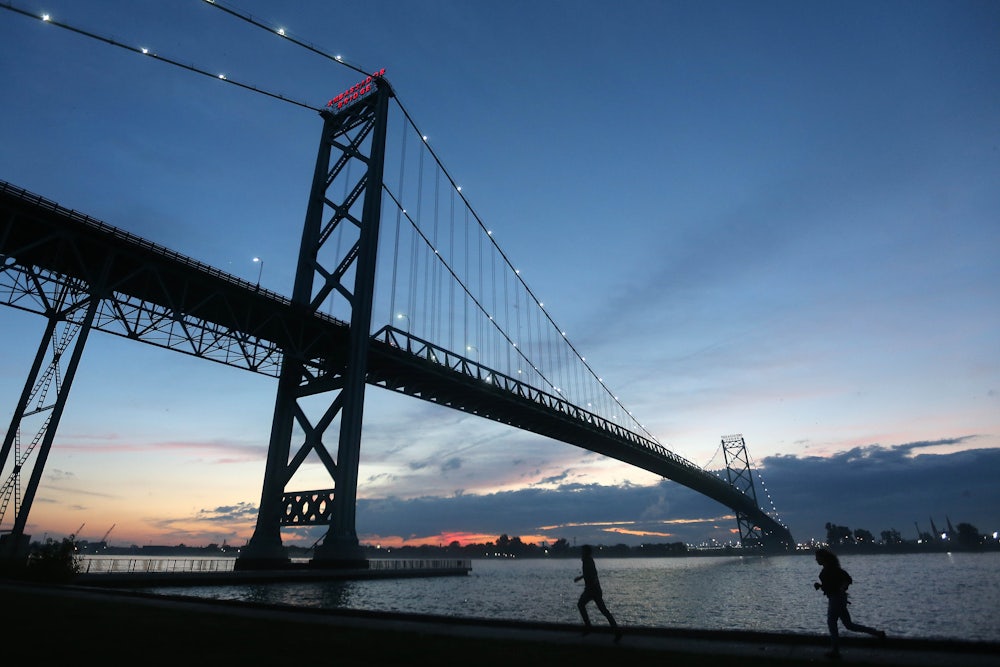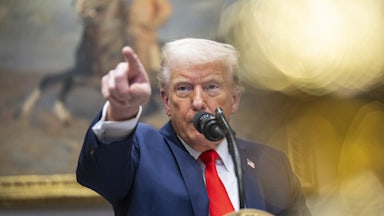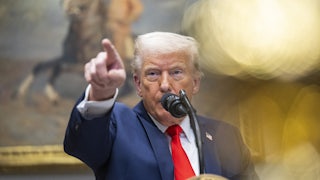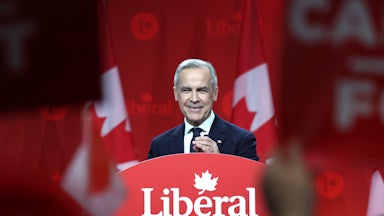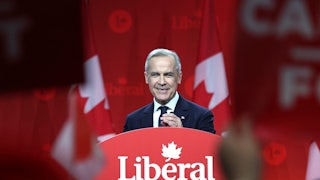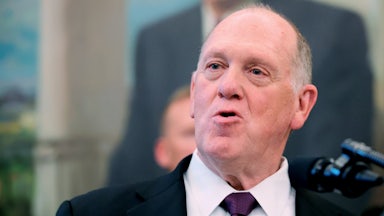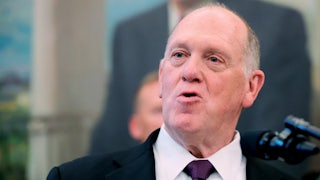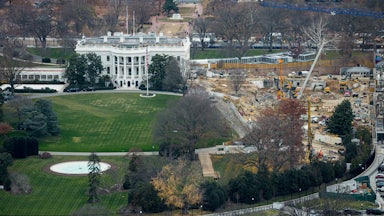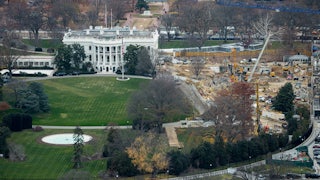For several summers, fumes from Canadian forest fires have polluted skies over both Canada and the northern United States, the smoke dimming the seasonal sunlight and fouling the air shared between two neighboring nations.
Another odor, this one metaphoric, also has descended upon the river cities of Detroit, Michigan, United States of America and Windsor, Ontario, Canada—municipalities similar in geography to Minneapolis–St. Paul or Oakland–San Francisco. The smell is the stench of the tariff and trade war of President Donald Trump against Canada.
Last spring—and again this summer—Trump launched large tariffs and petty insults at an allied nation and its leaders. He threatened an Anschluss to make Canada the fifty-first united state and to appoint the retired hockey star Wayne Gretzky as its governor. Ironic for this region was the timing of Trump’s attack: It came as the Gordie Howe International Bridge was being completed across the Detroit River between Detroit and Windsor to boost both commerce and social harmony between the two countries at their busiest land border crossing.
The Howe Bridge was officially scheduled to open this month, but elected officials now suggest early 2026 is more likely. The bridge honors a hockey hero from the prairie province of Saskatchewan who played right wing (just the hockey kind) for the Detroit Red Wings for 25 years (and for seven more seasons on other U.S.-based teams), from 1946 through 1980. Howe died in 2016. Much like Gretzky, Howe dominated his era. They called him “Mr. Hockey,” and he set a netful of records that Gretzky later broke. And one other thing about Howe: He personified the mutual benefits of immigrant labor and free trade between two nations whose cultures greatly overlap on a Venn diagram.
Under Trump, those Can-Am bonds have frayed. Among those fretting is Drew Dilkens, the mayor of Windsor, which has an unemployment rate of more than 10 per cent. Many of his 229,660 residents depend on the United States economically. He calls the new bridge “monumental” and said its opening—whenever it happens—should be a joyful celebration, something now hard to fathom.
“It’s the type of event that you’d expect a prime minister and a president to meet in the middle [of the bridge], shake hands, and celebrate the relationship,” Dilkens said in a recent interview at Windsor City Hall, the river visible from the window. “Hopefully, our trade relationship normalizes and stabilizes.”
The combined metropolitan area of the Detroit and Windsor region includes 5.7 million people, On the U.S. side, 645,705 live in Detroit proper, among 4.3 million citizens of southeastern Michigan. Ford and Stellantis, which have their world and U.S. headquarters, respectively, in greater Detroit, run big plants in Windsor. But mutual ties go beyond shipping automobile parts and finished cars between the Motor City and its Canadian cousin. The mayor said 6,000 daily commuters—mostly engineers and medical workers—cross the U.S. border for jobs but live on the Canadian side. Beyond that, citing military alliances with the U.S. on D-Day in World War II and, more recently, in Middle East wars, Dilkens said of Canada: “We’re not a goddamn neutral country. We are an ally and a friend. And we are there with you. And we’ve got to figure this out. Because it’s gone to a dark place, and it never had to.”
In August, Trump raised tariff rates from 25 percent to 35 percent on Canadian goods not covered by other tariffs (like those on steel and aluminum) or by the United States–Mexico-Canada Agreement, or USMCA. In his first term, Trump often crowed that the USMCA was a personal diplomatic triumph that replaced the North American Free Trade Agreement. But since then, he’s often said that Canada “has been ripping us off.”
The Howe Bridge (owned and paid for by Canada’s federal government) will compete with the 95-year-old, privately owned Ambassador Bridge, about two miles upriver. Further upriver, a tunnel runs under the river from downtown Detroit to downtown Windsor, but it cannot accommodate big trucks. The new, silver suspension bridge will be approximately 1.5 miles long and a half-mile high at its peak. It will have three motor lanes each way and space for both cyclists and pedestrians.
The cost is between $6 billion and $7 billion (Canadian), “and maybe more,” the mayor said. (A Canadian dollar is worth about 72 U.S. cents.) Canada will collect tolls in both directions (the amount hasn’t been set yet). On it, truckers will be able to drive directly between the American interstate highway system (I-75, which runs from Miami to Detroit) and the major Canadian 401 highway toward London, Ontario, and Toronto without lengthy traffic-light delays and volume jams on surface streets on the west side of Windsor. Although the span is complete and the Windsor-Detroit Bridge Authority spent the summer officially touting a September opening, Mayor Dilkens predicted, “I’m hearing rumors it may be spring” due to unfinished work on the customs and immigration sites on the land of both sides of the bridge.
Hearing the same rumors is U.S. Representative Shri Thanedar, whose Michigan 13th district ends at the Detroit River and includes the Howe bridge off-ramp. (In a geographic quirk, Detroit is actually north of Windsor.) Thanedar said the “sign-off” has not yet been completed from the construction company to the immigration officials of both nations.
“We are at least six months away, if not more,” Thanedar said in an August telephone interview. And he said he worried about more than just the timeline of the bridge opening. “I am greatly concerned about the tariffs and what that’s going to do to our bilateral relations,” he said. “Trump, in a short period of time, has managed to offend a lot of countries. One (Canada) is a neighboring, friendly country,” the congressman said, adding that the U.S. should not be “insulting our allies.”
Echoing this was David Cohen, the former U.S. ambassador to Canada, who told CNN: “We’ve hurt the Canadians. And it takes more to be able to build back a relationship when you’ve undercut the underpinnings of the relationship.”
Trump has justified his treatment of Canada with the accusation that undocumented immigrants and the drug fentanyl both cross illegally into the U.S. from Canada. Both Thanedar and Dilkens reject that assertion. “There may have been some of it,” Thanedar said, “but not on a grand scale.” Dilkens was more emphatic, saying that less than 1 percent of fentanyl seized by U.S. authorities last year came from Canada. As for immigration, the mayor added with a chuckle: “You could have a nitwit brain and understand ... the issue was from the Southern border into the U.S., not from the northern border into the U.S. We know it’s all nonsense, but it’s really hard to battle the guy who has the biggest microphone on the planet.”
Trump started the verbal war with Canada shortly after the 2024 election. He invited Prime Minister Trudeau to dine with him at Mar-a-Lago on November 29. Trump said then that Canada should be the fifty-first state and that Trudeau should be its governor. (Later, Trump switched to Gretzky.) “I look forward to seeing the governor again soon so that we may continue our in depth talks on tariffs and trade,” Trump posted on social media.
To this, Trudeau responded: “Even though you are a very smart guy, this is a very dumb thing to do. We two friends fighting is exactly what our opponents around the world want to see.” He added that Trump wanted “a total collapse of the Canadian economy because that will make it easier to annex us.” He added: “That is never going to happen. We will never be the 51st state.”
After that, Trump refused to return Trudeau’s phone calls. He’s turned a similar cold shoulder to the new prime minister, Mark Carney. When Carney visited the White House in May, Trump said—in his presence—that “we want to make our own cars. We don’t really want cars from Canada. We put tariffs on cars from Canada. At a certain point, it won’t make economic sense for Canada to build their cars.”
Things softened a bit in late August when the prime minister announced that he’d talked to Trump by phone and that Canada would cut back some retaliatory tariffs against the U.S. Trump later said, “We want to be very good to Canada.” At the same time, though, August saw the end of regular bus service between Detroit and Windsor. And Neil Young attacked Trump, although not by name, in a song called “Big Crime.” The 79-year-old dual citizen of the U.S. and Canada sang lines like “No more great again” and “Don’t want soldiers on our streets.”
Amid all this, there suddenly appeared many flags of the red maple leaf on a white background. Canadian hockey fans booed the American national anthem. Ontario native Mike Myers made the instantly viral “Elbows Up” commercial with Carney. Many felt menaced. Dilkens said he flashed back in his patriotic mind to the War of 1812, with gunboats on the Detroit River as the U.S. battled the British Empire, which then controlled what was called Upper Canada. In that war, England captured the American fort at Detroit. A few blocks from the Windsor mayor’s office is a city museum that proudly displays from that war the Tecumseh flag, a red banner with a Union Jack in the upper left corner. Tecumseh was an Indian chief allied with Great Britain.
The ambiguity of relations between the two nations continued in the nineteenth century when the Detroit-Windsor border became a convenient water crossing on the Underground Railroad, a human-trafficking system (the good kind) by which African Americans escaped human slavery, which then was legal in some United States.
Decades later, before a bridge or a tunnel, when commerce in alcohol was illegal in the United States, in the 1920s, the Detroit River became a convenient route for booze boats skipping from Canada over the water, which is, on average, 2,000 feet wide and 36 feet deep. In winter during Prohibition, cars and even trucks would cross the frozen surface.
Sometimes, the ice broke. The 1987 book The Ambassador Bridge, by Philip Mason, records one such discovery during the building of that crossing, which opened in 1929. It was a truck under the surface in 25 feet of water, according to the Wayne State University scholar. It had fallen through the ice with two hundred cases of contraband liquor. Also in the Roaring Twenties, the Detroit hockey team, originally called the Cougars, was founded—and played its first home games in Windsor.
During the Vietnam War, draft resisters crossed the border into Canada here and elsewhere to avoid American military service. In that same era, Canada and Detroit cross-pollinated musically both over the air and on the ground for the baby boom. A powerful Windsor radio station—CKLW, 800-AM—blasted Detroit’s Motown hits with its 50,000 watts to at least a dozen states and four provinces.
In Detroit’s small music clubs, talented Canadian performers like Joni Mitchell, Neil Young, and Gordon Lightfoot grew popular in the early stages of their careers. Young’s father, Toronto hockey writer Scott Young, appeared on Hockey Night in Canada. Detroit hockey fans watched it faithfully on Windsor TV because few Wings games were televised and they had to settle for the dreaded Toronto Maple Leafs. Hockey always linked Detroit and Windsor like a bridge.
And when the U.S. defeated the Soviet Union in Olympic hockey on a Friday afternoon in the 1980 Winter Games, en route to an epic gold medal, the American network ABC showed the upset of the USSR only on videotape delay that evening to manipulate its prime-time ratings. In so doing, the “American” Broadcasting Company cynically sacrificed a live event that was, arguably, the single most important American sports-news story of the era. However, a Canadian network, CTV, showed it live, and some households in Michigan watched it that way. That’s what friends are for.
Howe scored 801 NHL goals (and 975 overall, counting his later career in the short-lived World Hockey Association) by creating space for himself as a feared fistfighter (who rarely had to fight). He also created room with his elbows. The rallying cry of “Elbows Up!” used by Myers and others earlier this year drew directly from Howe-style hockey. In a 10-second TV news promo in heavy rotation on the Canadian Broadcasting Corporation, the term is heard in a call-and-response chant at a protest rally. Amid 12 camera cuts, the viewer sees: a sign that says “Forever Neighbours Never Neighbors” (with the u in the Canadian-British spelling in red and the American spelling in red, white and blue); a sign at a demonstration warning, “1812-1814. Do we have to show you again?” and another sign that shows an upside-down American flag next to the message, “Up with elbows, Down with fascism.”
In the spring, amid Trump’s economic saber-rattling, Canadian and American demonstrators rallied against Trump and for unity from both sides of the river, facing each other shore to shore, downtown Detroit to downtown Windsor, waving maple leaf flags and signs (a few fastened to hockey sticks). Some sang “O Canada.”
Among them was Elaine Weeks, an author and political activist whose father, Bert Weeks, served as mayor of Windsor from 1975 to 1982. Her father’s name adorns one of several riverside parks with impressive views of the river and the Detroit skyline. Elaine Weeks helped organize another protest on July 5. When a big blowup of a Trump photograph was posted under a large Canadian flag on the riverfront, Weeks and others pelted it with tomatoes (grown in Ontario) and TimBits, which are pastry pieces from the Tim Hortons donut shop.
Sitting on her Windsor front porch on a humid summer afternoon, Weeks fondly recalled her regular visits to Detroit. “I miss the Mexican food and going to the games and to the concerts and shopping at Trader Joe’s,” she said. “I can’t go across now. I would be taken at the border and never be seen again.” When asked if she may have been exaggerating the danger a wee bit, Weeks said Canadians recently have been questioned about their political views by U.S. border guards and that vacationing Canadians in Florida have been denied service in restaurants for wearing clothing showing the maple leaf.
Weeks and her husband, Chris Edwards, own the company Walkerville Publishing, and they specialize in books about the relationships between Detroit and Windsor. The brand echoes their east side neighborhood, Walkerville. It comes from the nearby Hiram Walker whiskey distillery, a riverfront landmark, which, when the wind is right, sends clouds of sweet fumes into the air across the water into Detroit’s east side. This fall, Walkerville Publishing will issue a new hardcover called A River Runs Between Us. Their website features a quote from President John F. Kennedy regarding Canada: “Geography has made us neighbors,” it says. “History has made us friends. Economics has made us partners.”
Another elected leader of that era was Pierre Trudeau, Justin’s father, who also served as Canada’s prime minister. In a 1969 visit to Washington, Trudeau famously said of the United States: “Living next to you is in some ways like sleeping with an elephant. No matter how friendly and even-tempered is the beast, if I can call it that, one is affected by every twitch and grunt.”
Those fond of symbolic metaphors might note that the elephant has now gone fully rogue; it is unfriendly and ill-tempered and loose from its cage, breaking and trampling everything in sight. Built to last at least a century, the Howe Bridge might support the weight of the rampaging beast, but it may leave cracks that only time can repair.
